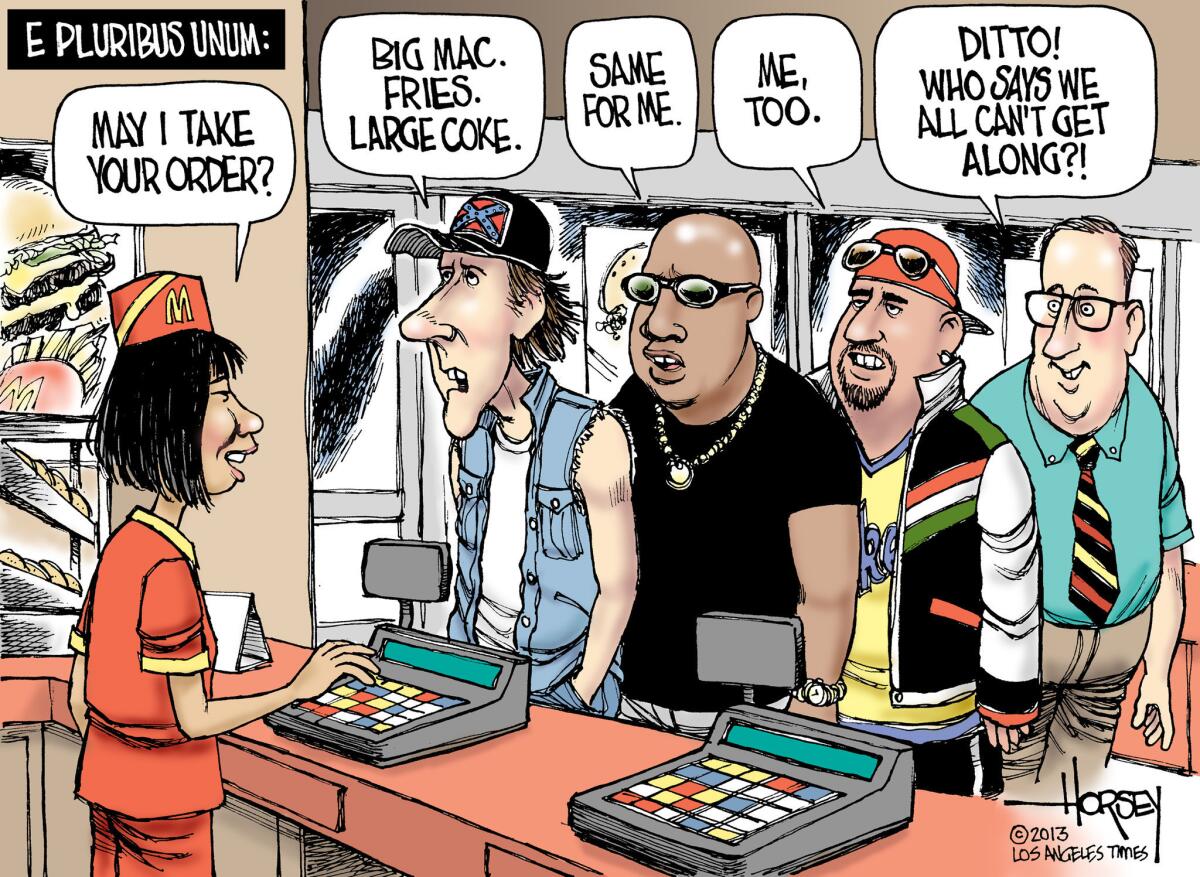Immigration is as American as a hamburger or an interstate drive

- Share via
Since the beginning of the republic, there has been a dynamic tension between constantly expanding diversity driven by immigration and the relentless homogenizing force of common American culture. And there’s nothing like a long drive on an interstate highway to remind a person of that reality.
On Monday, I traveled 600 miles on I-5 cutting through the center of California, from Redding to Los Angeles. The force of homogenization was apparent at every major exit and interchange. I was hungry, but I was hoping to find something beyond McDonald’s, Burger King, Subway, Wendy’s, Arby’s or Taco Bell. That was not an easy task.
As anyone who has driven an interstate anywhere in this great nation knows, the America one sees from the freeway lanes is the same from coast to coast. The fast-food restaurant choices are the same. The slower food choices are the same – Olive Garden, Denny’s, Pizza Hut and their equivalents. The stores are the same – Target, Best Buy, Starbucks, Wal-Mart.
There is comfort in this level of reliability. A traveler can always find a familiar vendor to buy the thing that did not make it into the suitcase or a hamburger that tastes exactly like the one at the last stop. Still, it can be dispiriting, as well. I remember driving down a highway in rural Indiana marveling that not a single shop or restaurant was unique to that place. It was franchised, homogenized America at its most appalling.
The happy surprise was to discover that, within a minute or two of turning off that Indiana highway, I was rolling through pristine farmland where Amish families riding in horse-drawn buggies sustained a unique culture. And that is still true in most places. I drive to Montana a couple of times a year, and I know once I exit the freeway and bypass the fast-food emporiums, I will find a little cafe filled with ranchers and farmers lunching on homemade soup and sandwiches and talking about the weather, their cows and the upcoming potluck at the VFW hall.
On Monday’s run down I-5, though, I was in a rush and had no time to find the unique places in the countryside that I know must be there. I had to seek diversity from another source: the radio.
Just out of Redding, Christian preachers hung out at the high end of the dial while country music stations predominated in the stronger frequencies. Those stations played song after song extolling the virtues of small towns, back-country roads and girls in tank tops and tight jeans eager to park down by the river and get frisky on the tailgate of a pickup truck.
Approaching Sacramento, the country songs faded and a political talk show took over. The host was part of the legion of small-time Rush Limbaughs across the country. This particular pundit was going off on guns and immigration, sometimes making sense, other times spouting hunches that veered seriously from verifiable facts.
I also began finding more unusual stations broadcasting from the Bay Area. On one, a man with a very earnest voice described how the Earth is actually a prison where all the psychotics from other planets are sent by the overlords of intergalactic civilization. That’s news you don’t hear just anywhere. Another station was nonstop hip-hop. Like the country music, there were reliable themes: wearing gold chains and gold watches, having sex, partying in the crib, having sex, hanging with the homies, having sex, voluptuous female bodies and having sex.
The college stations kicked in at various points. Some offered BBC reports from Jamaica, Mali, the Netherlands, Brazil and other locales most Americans cannot find on a map. Others played music by undiscovered alternative musicians who should probably stay undiscovered. The bad music was, at least, distinctive. On the pop stations, homogenization was really in evidence. Interchangeable divas – was that Beyonce or Mariah Carey? – sang interchangeable songs with bland “I want you, baby, I need you, baby” lyrics.
Strangely, on the Christian music station in the Central Valley, the music was essentially the same as on the secular stations, the main difference being that Jesus was substituted for the usual love interest in the songs. Somehow, making Christ sound like a really neat boyfriend seems vaguely sacrilegious.
The closer I drew to L.A. the more the Spanish-language stations took over. I suppose this is a clear example of diversity. On the other hand, most of the music sounded as formulaic as the pop and country tunes. (Does every Mexican song contain the word corazon?). One hombre stood out, however. Like them all, he was singing with a mariachi band blaring in the traditional three-beats-to-a-measure rhythm, but his voice sounded as if he had just rolled out of bed on the third day of a tequila binge. That was distinctive.
As night fell, I entered the swirl of L.A. traffic. National Public Radio was reporting that immigration reform is suddenly a popular item in Congress. That sounded good to me. We need the different sounds, tastes, talents and ideas that are brought to our shores from all over the world to be integrated, co-opted and fused onto old forms to create something distinctively American. After all, our national motto is E pluribus unum – one from many.
So, sure, secure the borders, but let’s not lock the doors. And please, let’s build some sushi bars at a few exits on the interstate.
More to Read
A cure for the common opinion
Get thought-provoking perspectives with our weekly newsletter.
You may occasionally receive promotional content from the Los Angeles Times.










